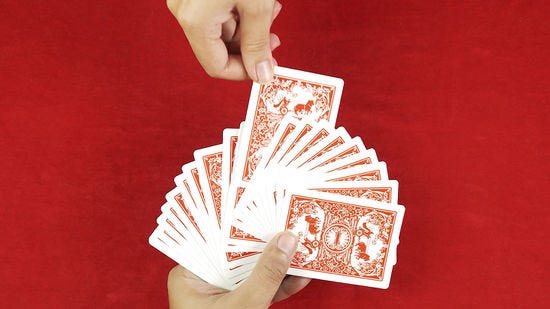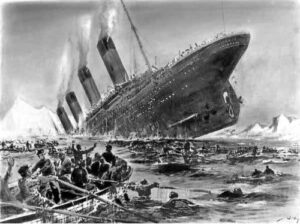A young Mark Twain had a vivid dream in which his brother died in an explosion. As recounted in a biography by Albert Paine, he was thoroughly shaken the next day. In his dream, Twain saw details, including a red rose on Henry’s chest as he lay in the casket. Two weeks later, Henry Clemens died in a boiler-room explosion aboard a steamship. At the funeral, Twain actually saw his brother’s body as he dreamed it, complete with rose, laid by a friend upon his chest as Twain watched.
What if Twain had been a bit more superstitious, or more trusting of his intuitions? Could he have prevailed on his brother to stay out of the boiler room, come hell or high water? Then he never would have had the experience for which the dream was a premonition. Would he still have had the premonition?
Maybe we can get hints from our future selves, but we have to experience the event in order to send the hint backward in time. The fact that we have had a premonition means that the event is unavoidable. As in the case of Oedipus Rex, our very efforts to avoid a predicted calamity will be woven by fate into the calamity’s cause.
If our premonitions of the future can do us no good, then why would be evolved to have these premonitions at all? For precognitive dreams or predilections to have any adaptive value, we must be able to learn from them how to dodge the bullet.
I wrote Friday, summarizing a video by Rupert Sheldrake about precognitive dreams and premonitions. I share his hypotheses (1) that the metaphysics of the universe somehow allows for knowledge of the future, and (2) that animals are evolved to tap into this knowledge because it helps us survive.
In one of the lab experiments described by Sheldrake, the subject’s physiology is stimulated (accelerated heart rate and sweating that lowers electrical resistance of the skin) before the subject is shown an emotionally upsetting picture. The natural interpretation is that the body is anticipating a future experience.
Is there another kind of premonition, based on events that never come to pass? One story I’ve heard is that someone gets a strange feeling while driving toward a green light, and he slows down just in time to see a big truck crossing in the other direction, speeding through his red light.
What good does it do to know that you’re going to be buried in an avalanche tomorrow or that you will be hit by a car? The only evolutionary value is if you can see a possible future and avoid it.

Dean Radin was decades ahead of us
Radin addressed this very question in an experimental setup 36 years ago. He conducted the experiment with crude programming tools available on a 1988 Macintosh, and he himself was the sole experimental subject, enduring 60,000 trials of guessing which of 6 pictures was going to come up next on his screen. A major investment of time.
Spoiler alert: He found strong statistical evidence (in this one experiment) that it is the potential future rather than the actual future that triggers precognition.
Here’s how the experiment worked:
For each trial (there are 60,000 trials) the computer is programmed to put 6 pictures on the screen and then choose one of them arbitrarily to have higher probability than the rest. Then Dean would make a guess which picture he was about to be shown. Then the computer would pick one of the pictures to be shown, but it would pick with biased probability — like loaded dice. Most of the time it would select the picture pre-selected with a high probability, but some of the time it would happen to pick one of the low-probability pictures.
The overall probability for each picture was still 1 in 6, but the preselection meant that each time there was an actual picture and a most probable picture, and sometimes they were not the same. This way, Radin could analyze not just how many times he hit the right photo, but also how many times he hit the most probable photo, even though it was “wrong”.
At this point in time, Radin was well aware of decades of experiments like this that established the reality of subconscious premonitions. What he hoped to do with this experiment was to learn not just from his hit rate but also the “misses”. Would the misses be biased in favor of the pre-selected, high probability picture?
Results: Of course, this effect is small. Odds were close to chance = 10,000 correct guesses out of 60,000. But, precognition works a little bit, so he did better than chance, and got a little more than 10,000 “correct”, meaning the actual photo. But what of the “misses”?
In the trials when the actual photo was different from the high-probability photo, which one was he more likely to pick? Was his premonition leading him toward the high-probability picture, or was his premonition leading him toward the picture that he was about to see (even in those cases when it was not pre-selected to be the high-probability picture)?
In fact, he scored 10,163 “correct” defined as the actual photo he was about to see. But he scored 10,282 “correct” defined as the pre-selected most probable photo.
In terms of probabilities, his 163 extra hits was modestly improbable, with odds of 30:1 against this level of success. But his 282 extra hits was quite improbable, with odds against chance of 1000:1.

Significance
I think that this was an important experiment, though I haven’t been able to find any others like it in the intervening 36 years. There have been many lab experiments (Sheldrake video) testing for precognition but besides this, there were none explicitly designed to tell whether our precognition points toward a probable future or an actual future in the cases where the two are different.
Remember Cassandra? The gods blessed her with the gift of seeing the future, but cursed her that no one believed her. So the they did nothing to avoid the future she foretold. (In fact, predicted the Trojan War and the fall of Troy if her brother, Paris, pursued his plan to kidnap and wed Helen. But Paris didn’t believe his sister, and the rest, as Homer tells us, is history.
The good news from Dr Radin is that this need not be the case. When premonitions warn of us of an event, it is only a probable event, and we might still avoid it.
But of course, this is one tentative result. We need more experiments like this.
I wrote to Radin, asking if there has been any follow-up, replicating his 1988 results. He responded with a current ms, a rough draft not yet submitted for publication. He has conducted an on-line replication of the 1988 experiment, and the response was overwhelming, with a quarter million participants and 85 million total trials. And the results? Stay tuned. I’ll report them when they are published.
Appendix for the computer scientist —
What does “probable future” mean?
Quickly, this gets deep. “Probable” can mean (at least) two things.
It can mean that the future really isn’t determined yet. There are quantum probabilities. There are decisions that are made by people who have free will. (Free will may or may not be connected to quantum indeterminacy.) There is this sense in which the future is truly unknowable.
But it might mean that the future is determined, but we don’t know what it is yet because the information simply hasn’t reached us, or because we’re not smart enough to calculate the physics that determines the future. For example, the winning lottery number has been drawn, but it will not be announced until tomorrow.
In the first case, the probable future may be avoided by some action we may take; but in the second case, there’s nothing we can do to avoid it.
Now (getting deeper into the weeds…) there are three kinds of random number generators in a computer.
- Most commonly, the computer just takes the last two random numbers it already has in memory, multiplies them together to create a very large number, say 64 digits, and then takes the middle 8 digits. Those 8 digits look pretty random, but if you knew the numbers you started with, you could figure out exactly what those 8 digits will be.
- The computer could also avoid using its last two random numbers in memory, which are fixed, by taking something that the user inputs as a seed for its calculation. Maybe it’s the particular pixel on the screen where the mouse is, or maybe it’s the timing of a mouse click, looking only at the fractional part of a second. Taking numbers like this and multiplying them together and then taking the middle 8 digits produces a number that is not predictable because human behavior is unpredictable.
- There are quantum random event generators (REGs) that are based on quantum noise or radioactive decay or some other process that is random according to quantum mechanics. These may be processed further, taking them as seeds, or they may be reported as-is because “quantum random” is supposed to be truly random.
So which kind of random number generator did Radin use? After the first step was done and one photo was pre-selected as most probable, what kind of random process did he use to decide which would be the actual picture (shown to the experimental subject, who was also Radin)?
Answer: Radin used #2. The exact time of a mouse movement was used to seed the pseudorandom number generator. Thus the choice of which picture to display was not “determined but unknown”, but nor was it quantum random. It was determined by unconscious movements of the subject himself, via an intricately tortuous path through the computer’s pseudorandom number algorithm.
Quantum random event generators (REGs) are cheap and available today, and psi experimenters use them freely. But in 1988, Radin would have had to cobble one together out of parts and do the calibration and testing himself.
There’s no reason this experiment could not be repeated today with a diverse group of subjects and a true quantum REG. Something tells me that the results will be really, really important.
